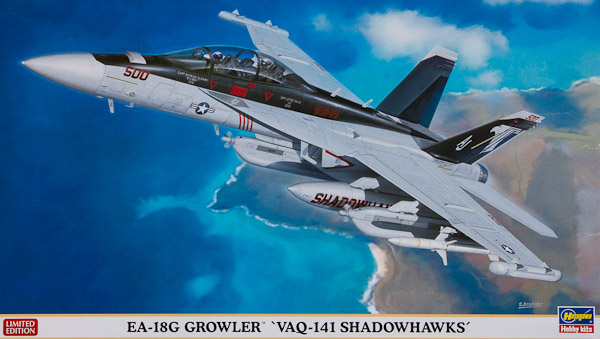
Hasegawa 1/72 EA-18G Growler
By Daniel Carey
Overview
With the Grumman EA-6B Prowler reaching the end of its service life, the US Navy looked to the Super Hornet to replace the EA-6B as the Navy's electronic warfare aircraft. Boeing fitted the F/A-18F with the ALQ-99 EW system in 2001, demonstrating the concept, and the first EA-18G test aircraft rolled out in August 2006. By using the same airframe as the standard Super Hornet, the Growler's flight performance allows the EA-18G to easily fly with F/A-18 Super Hornets on combat missions. It also simplifies parts and maintenance issues as the Super Hornet becomes the primary aircraft on Navy carrier decks.
In the EA-18G Growler the nose cannon was replaced with dedicated EW equipment. The Growler kept all the Super Hornet underwing stations, the fuselage missile stations, and the centerline station. The wingtip missile rails of the F/A-18F were replaced with electronics pods. The Growler, therefore, is a more potent offensive platform than the Prowler it's replacing, and the advances in EW equipment give it more capabilities as well as provide room for future growth. The first EA-18G entered squadron service with VAQ-129 in June 2008, and the Growler will slowly replace the EA-6B Prowler over the next few years.
The Kit
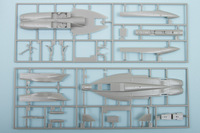 This is the second release of the Hasegawa EA-18G Growler, and appears to contain the same sprues as their first Growler kit, #01568 for VAQ-132 Scorpions. Molded in the standard light gray plastic, the kit features petite recessed panel lines, nicely detailed parts, and a nice decal sheet with markings for two aircraft. The part count is given as 177 pieces. The Growler kit contains the same sprues as the Hasegawa F/A-18F Super Hornet kit, with the exception of having the raised fuselage vents between the tails instead of the flush vents seen on the earlier F/A-18F.
This is the second release of the Hasegawa EA-18G Growler, and appears to contain the same sprues as their first Growler kit, #01568 for VAQ-132 Scorpions. Molded in the standard light gray plastic, the kit features petite recessed panel lines, nicely detailed parts, and a nice decal sheet with markings for two aircraft. The part count is given as 177 pieces. The Growler kit contains the same sprues as the Hasegawa F/A-18F Super Hornet kit, with the exception of having the raised fuselage vents between the tails instead of the flush vents seen on the earlier F/A-18F.
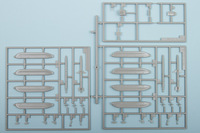 The Hasegawa Growler kit includes the following stores on the common Super Hornet sprues:
The Hasegawa Growler kit includes the following stores on the common Super Hornet sprues:
four wing fuel tanks,
two AIM-120 AMRAAM missiles,
two AIM-9X sidewinder missiles (not used).
In addition the Growler kit includes four new sprues with the parts needed for the Growler including:
two wing tip ALQ-218 pods,
four ALQ-99 high band jamming pond for the wings,
one ALQ-99 low band pond for the centerline station,
two AGM-88E AARGM (advanced anti-radiation guided missile).
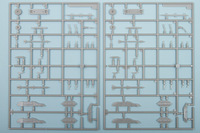 Hasegawa provides enough stores to fill the wing stations with a variety of loads, with some leftovers for your spares box for future Growlers or Super Hornets.
Hasegawa provides enough stores to fill the wing stations with a variety of loads, with some leftovers for your spares box for future Growlers or Super Hornets.
As with most kits, construction starts with the cockpit. Since the Growler is based on the two-seat F/A-18F there are two offices to work with. The cockpit is relatively simple with a tub, two flat instrument panels, and the pilot's control stick. Decals provide the detail for the instrument panels and side consoles. Hasegawa provided a different rear cockpit coaming, instrument panel, and decal to reflect the difference in the rear cockpit of the EA-18G. The NACES SJU-17 ejection seats are molded in one piece that shows the basic shape of the NACES seat, but does not have much surface detail. The completed cockpit then sits on top of the lower front fuselage piece, which is then sandwiched between two nose halves.
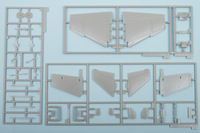 The three-piece nose assembly is bit complicated, owing to the complex shape of the Super Hornet and Growler. In addition to the three nose pieces, the fuselage is further split into a rear upper and lower half, with separate side and intake assemblies. Caution is needed when assembling the three-piece nose section to make sure it fits smoothly to the adjacent lower fuselage section.
The three-piece nose assembly is bit complicated, owing to the complex shape of the Super Hornet and Growler. In addition to the three nose pieces, the fuselage is further split into a rear upper and lower half, with separate side and intake assemblies. Caution is needed when assembling the three-piece nose section to make sure it fits smoothly to the adjacent lower fuselage section.
The intakes are simplified straight sections ending at a blank face about 3/8-inch back from the lower edge of the intake. Some ejection marks, and possibly a seam line, will need to be filled on the inside of the intakes.
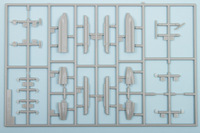 Once the fuselage is together, assembling the wings and tail planes are the next major step. The wings are split into upper and lower halves with leading and trailing edge flaps molded in the retracted position. Flap and aileron hinges are molded separately and glued on to the bottom of the wing.
Once the fuselage is together, assembling the wings and tail planes are the next major step. The wings are split into upper and lower halves with leading and trailing edge flaps molded in the retracted position. Flap and aileron hinges are molded separately and glued on to the bottom of the wing.
The vertical fins and stabilizers are the same as in the Hasegawa Super Hornet kits. A polycap assemble is provided in the fuselage for the horizontal stabilizers, allowing the stabilizers to remain off the model while painting, then inserted into the fuselage when the model is complete, a nice feature. The polycap also allows the stabilizers to be positioned as desired without gluing.
 Moving on to the underside, first up is the landing gear, which are nicely detailed for this scale. The landing gear wheels are smooth, rather than having some straight tread as seen on the actual aircraft wheels. The wheel hubs are well detailed for this scale. The nose and main wheel wells are deep and include some internal framing and details. The landing gear doors are reasonably thin, with some detail molded in. Ejector pin marks will need to be removed from each door.
Moving on to the underside, first up is the landing gear, which are nicely detailed for this scale. The landing gear wheels are smooth, rather than having some straight tread as seen on the actual aircraft wheels. The wheel hubs are well detailed for this scale. The nose and main wheel wells are deep and include some internal framing and details. The landing gear doors are reasonably thin, with some detail molded in. Ejector pin marks will need to be removed from each door.
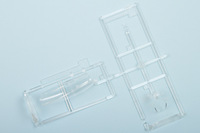 Hasegawa includes a two-piece clear canopy that can be posed either opened or closed.
Hasegawa includes a two-piece clear canopy that can be posed either opened or closed.
With the basics out of the way, it's time to look at specific changes Hasegawa made for the EA-18G Growler. First up, the most noticeable change from the original Hasegawa F/A-18F kit is the vent stacks on the rear fuselage. The original kit had a flush vent between the vertical fins that was found on early Super Hornets, while this kit has the ten individual stacks. Looking at the underside of the fuselage part, one can clearly see where this insert was put in. What is unknown is if this is a permanent mold change or not. Given that most Super Hornets now have these vents, a permanent change would not be a bad thing.
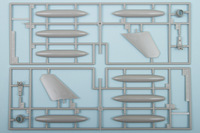 The instructions note that the gun opening and vent holes need to be filled in, since the gun is not carried. What the instructions fail to mention is that seven gun vents on the lower nose forward of the nose gear bay need to be filled in as well. Some other panel lines on the forward fuselage are noted to be filled in, and a small diamond shaped extrusion is shown being removed (however a Growler photo I saw showed the diamond still present on the right side of the nose).
The instructions note that the gun opening and vent holes need to be filled in, since the gun is not carried. What the instructions fail to mention is that seven gun vents on the lower nose forward of the nose gear bay need to be filled in as well. Some other panel lines on the forward fuselage are noted to be filled in, and a small diamond shaped extrusion is shown being removed (however a Growler photo I saw showed the diamond still present on the right side of the nose).
There are seven electronic sensors/bumps on the fuselage that Hasegawa has included. The largest is part R2 for the electronic bump on the top of the fuselage spine. From photos of the actual aircraft it appears that actual sensor is not as tall as part R2, and tapers more smoothly into the fuselage. There are four parts for electronic bumps on the rear of the fuselage (S2,3 and S4,5) and two for electronic bumps on the nose (T4).
The Growler has two changes in the wing that Hasegawa has provided parts for: a wing fence is included for the upper surface of the wing, and an extra section for the leading edge of the wing was added on the inside of the sawtooth edge of the outer wing. The wing tip formation lights need to be trimmed off to install the wingtip ALQ-218 pods. The ALQ wingtip pods are nicely detailed with separate fins. Decals for the formation lights on the top and bottom of the ALQ pods are included.
The wing fold vent holes are another Super Hornet feature that seems to have been removed on the Growler. A photo of this specific aircraft (AJ 500) shows no vent holes in the wing fold. In that case decal number 126 with the vent holes should not be used.
Decals
The decal sheet is very thorough and includes numerous stencils for various warnings and notices, and a variety of vents found all over the airframe, including the inside of the intakes. The color and register appear to be very good, the small print is sharp. The decals are very nicely printed and should go down with no problems.
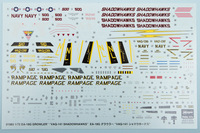 There are two choices for the actual squadron markings. The first is the boxtop scheme VAQ-141 "Shadowhawks", a CAG aircraft from the USS George HW Bush (CVN-77). This aircraft has a black tail and spine with red trim. The black color will need to be painted, which is preferable over having to apply a large decal. The second option is an aircraft from VAQ-138 "Yellow Jackets". It has black rudders, a partially black spine, and yellow trim and lettering. There's a yellow hornet on the tail and yellow lightning bolts below the cockpit. VAQ-141 Shadowhawks and VAQ-138 Yellow Jackets transitioned to the Growler in 2010.
There are two choices for the actual squadron markings. The first is the boxtop scheme VAQ-141 "Shadowhawks", a CAG aircraft from the USS George HW Bush (CVN-77). This aircraft has a black tail and spine with red trim. The black color will need to be painted, which is preferable over having to apply a large decal. The second option is an aircraft from VAQ-138 "Yellow Jackets". It has black rudders, a partially black spine, and yellow trim and lettering. There's a yellow hornet on the tail and yellow lightning bolts below the cockpit. VAQ-141 Shadowhawks and VAQ-138 Yellow Jackets transitioned to the Growler in 2010.
Conclusion
While some might complain about the extra work to make an accurate Growler from this kit, realistically this is the best balance between cost and detail. Hasegawa did go the extra step to provide the information in the instructions for modifying the panel lines, and the actual Growler parts are very nicely done. That, plus the vent stack update to the fuselage results in a good compromise that should not tax most modelers and will result in a very nice model of the EA-18G Growler. My thanks to Hasegawa USA for the review sample.
